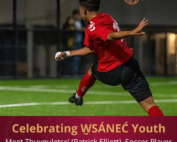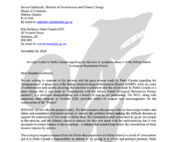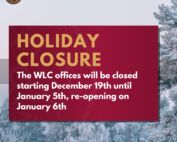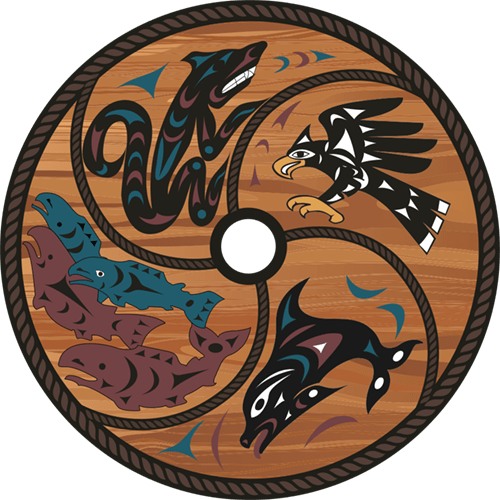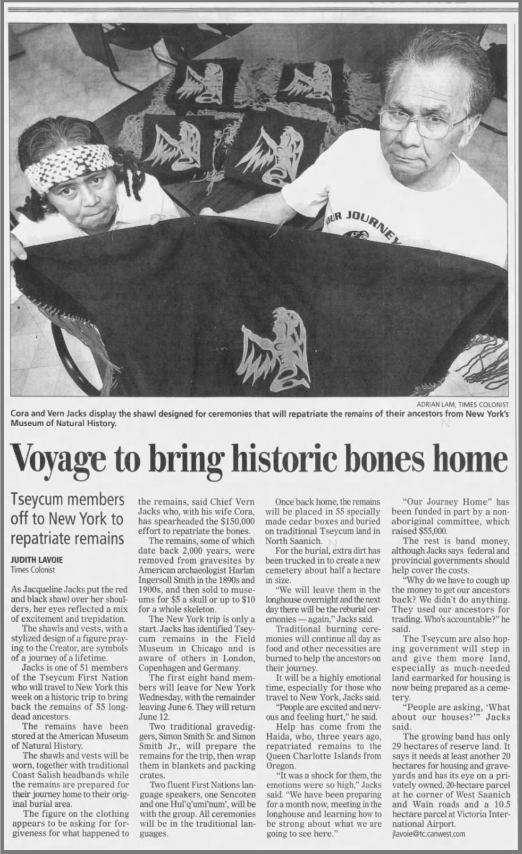
Times Colonist: June 2, 2008
[IMAGE]
ADRIAN LAM, TIMES COLONIST
Cora and Vern Jacks display the shawl designed for ceremonies that will repatriate the remains of their ancestors from New York’s Museum of Natural History.
Voyage to bring historic bones home
Tseycum members off to New York to repatriate remains
JUDITH LAVOIE
Times Colonist
As Jacqueline Jacks put the red and black shawl over her shoulders, her eyes reflected a mix of excitement and trepidation.
The shawls and vests, with a stylized design of a figure praying to the Creator, are symbols of a journey of a lifetime.
Jacks is one of 51 members of the Tseycum First Nation who will travel to New York this week on a historic trip to bring back the remains of 55 long-dead ancestors.
The remains have been stored at the American Museum of Natural History.
The shawls and vests will be worn, together with traditional Coast Salish headbands while the remains are prepared for their journey home to their original burial area.
The figure on the clothing appears to be asking for forgiveness for what happened to
the remains, said Chief Vern Jacks who, with his wife Cora, has spearheaded the $150,000 effort to repatriate the bones.
The remains, some of which date back 2,000 years, were removed from gravesites by American archaeologist Harlan Ingersoll Smith in the 1890s and 1900s, and then sold to museums for $5 a skull or up to $10 for a whole skeleton.
The New York trip is only a start. Jacks has identified Tseycum remains in the Field Museum in Chicago and is aware of others in London, Copenhagen, and Germany.
The first eight band members will leave for New York Wednesday, with the remainder leaving June 6. They will return June 12.
Two traditional gravediggers, Simon Smith Sr. and Simon Smith Jr., will prepare the remains for the trip, then wrap them in blankets and packing crates.
Two fluent First Nations language speakers, one Sencoten and one Hul’q’umi’num’, will be with the group. All ceremonies will be in the traditional languages.
Once back home, the remains will be placed in 55 specially-made cedar boxes and buried on traditional Tseycum land in North Saanich.
For the burial, extra dirt has been trucked in to create a new cemetery about half a hectare in size.
“We will leave them in the longhouse overnight and the next day there will be the reburial ceremonies – again,” Jacks said.
Traditional burning ceremonies will continue all day as food and other necessities are burned to help the ancestors on their journey.
It will be a highly emotional time, especially for those who travel to New York, Jacks said.
“People are excited and nervous and feeling hurt,” he said.
Help has come from the Haida, who, three years ago, repatriated remains to the Queen Charlotte Islands from Oregon.
“It was a shock for them, the emotions were so high,” Jacks said. “We have been preparing for a month now, meeting in the longhouse and learning how to be strong about what we are going to see here.”
“Our Journey Home” has been funded in part by a non-aboriginal committee, which raised $55,000.
The rest is band money, although Jacks says federal and provincial governments should help cover the costs.
“Why do we have to cough up the money to get our ancestors back? We didn’t do anything. They used our ancestors for trading. Who’s accountable?” he said.
The Tseycum are also hoping government will step in and give them more land, especially as much-needed land earmarked for housing is now being prepared as a cemetery.
“People are asking, ‘What about our houses?’” Jacks said.
The growing band has only 29 hectares of reserve land. It says it needs at least another 20 hectares for housing and graveyards and has its eye on a privately owned, 20-hectare parcel at he corner of West Saanich and Wain roads and a 10.5 hectare parcel at Victoria International Airport.
jlavoie@tc.canwest.com



